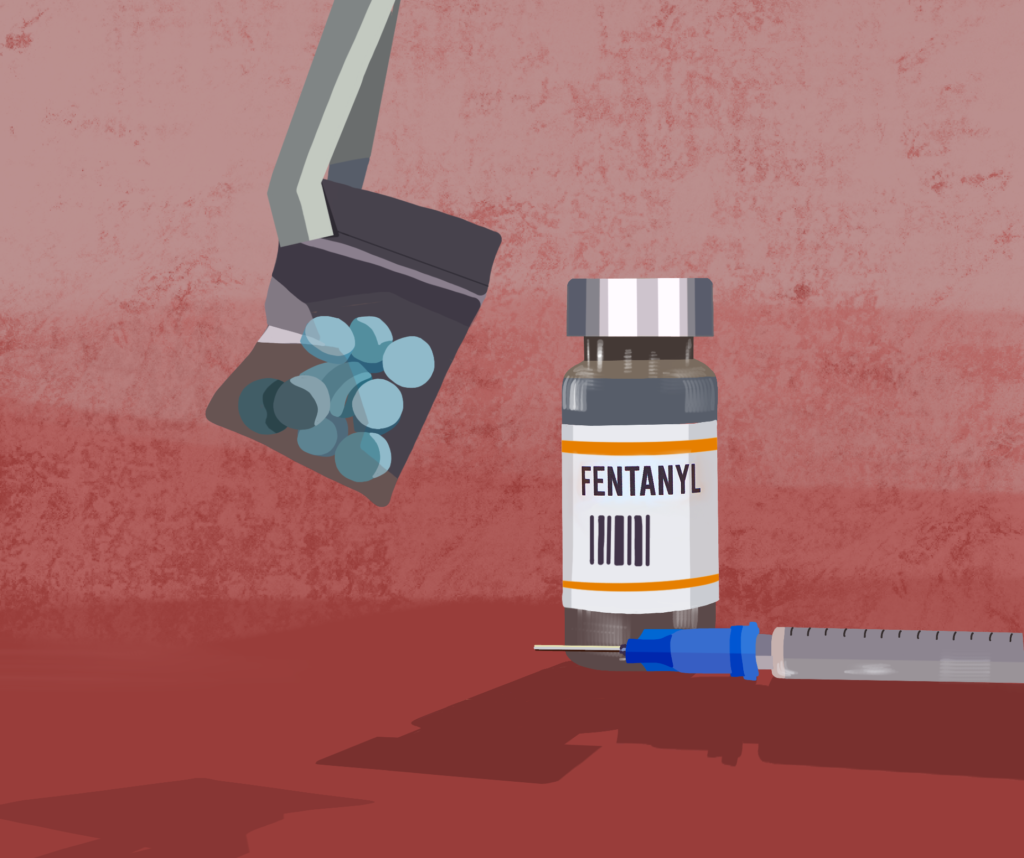
Graphic by Yujin Kim/The Choate News
While Covid-19 related deaths dominated headlines in 2020, fentanyl, a synthetic opioid, is taking more lives than ever before, yet has received much less coverage.
According to the Centers for Disease Control and Prevention (CDC), in 2021, more people aged 18-45 in the United States died from fentanyl overdoses than from Covid-19, suicide, and car accidents combined. The number totals around 79,000 Americans. What’s even more concerning is that a large concentration of these deaths are are composed of a younger demographic. According to an analysis of California state data by The Guardian, fentanyl deaths were rare just five years ago, but now, a person under the age of 24 overdoses on the opioid every 12 hours — a 1,000% increase from 2018.
The current fentanyl crisis is tied to a larger issue — an ongoing opioid epidemic. In response, major pharmaceutical companies have tightened their grip on prescription pill regulations following legal pursuits, making these pills less prevalent on the black market. The synthetic opioid was previously popular because it is up to 100 times more potent than heroin and a lot cheaper. Furthermore, the substance can be mixed with traditional street drugs such as heroin, cocaine, methamphetamine, and marijuana, and also can be cut into millions of pills that mimic traditional pharmaceuticals. The danger of the camouflaged fentanyl lies in its potency: consumed correctly, it can give users the sensation of euphoria and relieve extreme pain; consumed incorrectly, an amount the size of three grains of sand can be fatal. In addition, the opioid itself is easy to attain compared to other drugs, as it can be made in illegal labs that are directly available to dealers. This gives sellers an irrefutable opportunity for profit, which, to them, outweighs the deadly cost.
What has encouraged the recent rise in the consumption of fentanyl and other substances among the younger demographic? Whether it’s attempting to seem “cool” or “edgy” or to showcase the detrimental effects of drug usage, the media marketed toward teens, such as popular shows including “Euphoria,” “Shameless,” “Skins,” and countless others, have begun exhibiting a more prevalent theme of romanticizing drugs use in their content.
In “Euphoria,” the main character, Rue, is close friends with a drug dealer, Fezco. One of Fez’s friends offers a portion of fentanyl served on the tip of a blade. Rue consumes the substance, fading into oblivion and murmuring about how happy she is. Fez immediately goes to grab Narcan, a drug that prevents opioid overdoses from becoming fatal. Although the showrunners of Euphoria claim the vivid depiction of the effects of drugs are instilled in order to desensitize users to the detrimental impact of drugs, portraying drugs as a trend sends the wrong message to young viewers. For teenagers who may not be able to grasp the intended meaning behind the show, the content could prove detrimental.
The impact of media on drug usage doesn’t stop in popular fiction. It is commonplace among social media influencers and celebrities as well, who are supposed to be seen as role models to their younger audience. Whether it is a one-liner in their most popular album or a social-media post depiciting themselves consuming substances, the casual exposure has the same detrimental influence. Social media is also a way for sellers to reach a wider customer base than on streets and alleyways. They are able to advertise their pills to vulnerable social media users — most of whom are teenagers — and sell their pills in a more efficient manner. This is where the danger lies. Only a number of people who overdosed on fentanyl actually knew what they were consuming. Most thought it was Percocet or Xanax, unaware that the pill in their hand was a dose fatal enough to kill four adult men.
The opioid crisis has been ongoing for decades. While completely cutting off drugs from the source does not seem like a practical short-run solution, censoring what young people are able to consume via media is viable. Jennifer Park Stout, vice-president of global public policy at the social media platform Snapchat, said in an October Senate hearing that Snapchat was “absolutely determined to remove all drug dealers” from its site. “What is happening on our platforms — and all across social media and technology platforms — is that young people who are suffering from mental health and stress induced by the pandemic … are reaching for substances, oftentimes pills and opioids,” she said. “But these substances are laced with fentanyl, enough fentanyl to kill them.”
In order to keep the next generation safe, it is important for people in control — whether it be the CEOs of internet companies, influencers, celebrities, or show runners — to thoroughly consider what media content they want to expose to young audiences and how these audiences are consuming it. It is especially important for the government to tighten the rein on highly toxic and addictive substances like fentanyl by enforcing strong regulations. Otherwise, the inconspicuous production and distribution will continue, and the already high numbers of deaths from overdoses will continue to climb.




